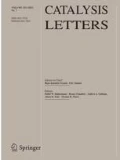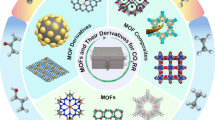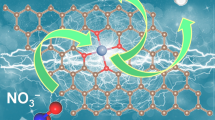Abstract
Facilely tailored electrocatalyst with high-efficiency and durability for carbon dioxide (CO2) to carbon monoxide (CO) conversion is appealing but remains challenging. Herein, small nickel nanoparticles (about 19.4 nm) confined in nitrogen-doped carbon (Ni NPs@N–C) with narrow size distribution are successfully constructed via a facile one-step calcination strategy of Ni containing MOF compounds. By virtue of the protective N-doped graphitized carbon shell and the uniformly distributed fine Ni nanoparticles in a narrow range from 13 to 21 nm, the as-obtained Ni NPs@N–C can exclusively convert CO2 into CO with excellent Faradaic efficiency (FE) of 96.8% at − 1.0 V (vs. RHE), as well as the superior long-term catalytic stability over 24 h. Moreover, a high current density of more than 200 mA cm−2 with a stable CO FE of 92% can be achieved in a flow cell configuration. This work paves a new way for the facile and potentially scale preparation of small metal nanoparticles for efficient CO2- to-CO conversion.
Graphic Abstract





Similar content being viewed by others
References
Wang L, Chen W, Zhang D, Du Y, Amal R, Qiao S, Wu J, Yin Z (2019) Surface strategies for catalytic CO2 reduction: from two-dimensional materials to nanoclusters to single atoms. Chem Soc Rev 48(21):5310–5349
Vasileff A, Zheng Y, Qiao SZ (2017) Carbon solving carbon’s problems: recent progress of nanostructured carbon-based catalysts for the electrochemical reduction of CO2. Adv Energy Mater 7(21):1700759
Hou L, Yan J, Takele L, Wang Y, Yan X, Gao Y (2019) Current progress of metallic and carbon-based nanostructure catalysts towards the electrochemical reduction of CO2. Inorg chem 6(12):3363–3380
Seh ZW, Kibsgaard J, Dickens CF, Chorkendorff I, Norskov JK, Jaramillo TF (2017) Combining theory and experiment in electrocatalysis: insights into materials design. Science 355:6321
Jiang X, Li H, Xiao J, Gao D, Si R, Yang F, Li Y, Wang G, Bao X (2018) Carbon dioxide electroreduction over imidazolate ligands coordinated with Zn(II) center in ZIFs. Nano Energy 52:345–350
Kibria MG, Edwards JP, Gabardo CM, Dinh CT, Seifitokaldani A, Sinton D, Sargent EH (2019) Electrochemical CO2 reduction into chemical feedstocks: from mechanistic electrocatalysis models to system design. Adv Mater 31(31):1807166
Jia M, Choi C, Wu TS, Ma C, Kang P, Tao H, Fan Q, Hong S, Liu S, Soo YL, Jung Y, Qiu J, Sun Z (2018) Carbon-supported Ni nanoparticles for efficient CO2 electroreduction. Chem Sci 9(47):8775–8780
Pan F, Deng W, Justiniano C, Li Y (2018) Identification of champion transition metals centers in metal and nitrogen-codoped carbon catalysts for CO2 reduction. Appl Catal B 226:463–472
Zhu DD, Liu JL, Qiao SZ (2016) Recent advances in inorganic heterogeneous electrocatalysts for reduction of carbon dioxide. Adv Mater 28(18):3423–3452
Nielsen DU, Hu XM, Daasbjerg K, Skrydstrup T (2018) Chemically and electrochemically catalysed conversion of CO2 to CO with follow-up utilization to value-added chemicals. Nat Catal 1(4):244–254
Hernández S, Amin Farkhondehfal M, Sastre F, Makkee M, Saracco G, Russo N (2020) Syngas production from electrochemical reduction of CO2: current status and prospective implementation. Green Chem 19(10):2326–2346
Peng X, Karakalos SG, Mustain WE (2018) Preferentially oriented Ag nanocrystals with extremely high activity and faradaic efficiency for CO2 electrochemical reduction to CO. ACS Appl Mater Interfaces 10(2):1734–1742
Back S, Kim JH, Kim YT, Jung Y (2016) Bifunctional interface of Au and Cu for improved CO2 electroreduction. ACS Appl Mater Interfaces 8(35):23022–23027
Li X, Xi S, Sun L, Dou S, Huang Z, Su T, Wang X (2020) Isolated FeN4 sites for efficient electrocatalytic CO2 reduction. Adv Sci (Weinh) 7(17):2001545
Jiang K, Siahrostami S, Zheng T, Hu Y, Hwang S, Stavitski E, Peng Y, Dynes J, Gangisetty M, Su D, Attenkofer K, Wang H (2018) Isolated Ni single atoms in graphene nanosheets for high-performance CO2 reduction. Energy Environ Sci 11(4):893–903
Zhao C, Dai X, Yao T, Chen W, Wang X, Wang J, Yang J, Wei S, Wu Y, Li Y (2017) Ionic Exchange of metal-organic frameworks to access single nickel sites for efficient electroreduction of CO2. J Am Chem Soc 139(24):8078–8081
Li X, Bi W, Chen M, Sun Y, Ju H, Yan W, Zhu J, Wu X, Chu W, Wu C, Xie Y (2017) Exclusive Ni-N4 sites realize near-unity CO selectivity for electrochemical CO2 reduction. J Am Chem Soc 139(42):14889–14892
Yang HB, Hung SF, Liu S, Yuan K, Miao S, Zhang L, Huang X, Wang HY, Cai W, Chen R, Gao J, Yang X, Chen W, Huang Y, Chen HM, Li CM, Zhang T, Liu B (2018) Atomically dispersed Ni(i) as the active site for electrochemical CO2 reduction. Nat Energy 3(2):140–147
Chen SX, Li YW, Bu ZG, Yang FQ, Luo JH, An QZ, Zeng ZL, Wang J, Deng SG (2021) Boosting CO2-to-CO conversion on a robust single-atom copper decorated carbon catalyst by enhancing intermediate binding strength. J Mater Chem A 9(3):1705–1712
Ju W, Bagger A, Hao GP, Varela AS, Sinev I, Bon V, Roldan Cuenya B, Kaskel S, Rossmeisl J, Strasser P (2017) Understanding activity and selectivity of metal-nitrogen-doped carbon catalysts for electrochemical reduction of CO2. Nat Commun 8(1):1–9
Bi W, Li X, You R, Chen M, Yuan R, Huang W, Wu X, Chu W, Wu C, Xie Y (2018) Surface immobilization of transition metal ions on nitrogen-doped graphene realizing high-efficient and selective CO2 reduction. Adv Mater 30(18):1706617
Li Z, He D, Yan X, Dai S, Younan S, Ke Z, Gu J (2020) Size-dependent nickel-based electrocatalysts for selective CO2 reduction. Angew Chem 132(42):18731–18736
Yang F, Jiang C, Ma M, Shu F, Mao X, Yu W, Wang J, Zeng Z, Deng S (2020) Solid-state synthesis of Cu nanoparticles embedded in carbon substrate for efficient electrochemical reduction of carbon dioxide to formic acid. Chem Eng J 400:125879
Wu D, Wang X, Fu XZ, Luo JL (2020) Ultrasmall Bi nanoparticles confined in carbon nanosheets as highly active and durable catalysts for CO2 electroreduction. Appl Catal B 284:119723
Daiyan R, Lu X, Tan X, Zhu X, Chen R, Smith SC, Amal R (2019) Antipoisoning nickel-carbon electrocatalyst for practical electrochemical CO2 reduction to CO. ACS Appl Energy Mater 2(11):8002–8009
Liu S, Yang H, Huang X, Liu L, Cai W, Gao J, Li X, Zhang T, Huang Y, Liu B (2018) Identifying active sites of nitrogen-doped carbon materials for the CO2 reduction reaction. Adv Funct Mater 28(21):1800499
Yu W, Shu F, Huang Y, Yang F, Meng Q, Zou Z, Wang J, Zeng Z, Zou G, Deng S (2020) Enhanced electrocatalytic nitrogen reduction activity by incorporation of a carbon layer on SnS microflowers. J Mater Chem A 8(39):20677–20686
Guo H, Zheng Z, Zhang Y, Lin H, Xu Q (2017) Highly selective detection of Pb2+ by a nanoscale Ni-based metal–organic framework fabricated through one-pot hydrothermal reaction. Sens Actuators B 248:430–436
Guo C, Zhang Y, Guo Y, Zhang L, Zhang Y, Wang J (2018) A general and efficient approach for tuning the crystal morphology of classical MOFs. Chem Commun (Camb) 54(3):252–255
Mao F, Liu PF, Yang P, Gu J, Yang HG (2020) One-step coating of commercial Ni nanoparticles with a Ni, N-co-doped carbon shell towards efficient electrocatalysts for CO2 reduction. Chem Commun (Camb) 56(54):7495–7498
Mateo D, Albero J, García H (2018) Graphene supported NiO/Ni nanoparticles as efficient photocatalyst for gas phase CO2 reduction with hydrogen. Appl Catal B 224:563–571
Sevilla M, Fuertes AB (2006) Catalytic graphitization of templated mesoporous carbons. Carbon 44(3):468–474
Artyushkova K, Kiefer B, Halevi B, Knop-Gericke A, Schlogl R, Atanassov P (2013) Density functional theory calculations of XPS binding energy shift for nitrogen-containing graphene-like structures. Chem Commun (Camb) 49(25):2539–2541
Kabir S, Artyushkova K, Kiefer B, Atanassov P (2015) Computational and experimental evidence for a new TM-N3/C moiety family in non-PGM electrocatalysts. Phys Chem Chem Phys 17(27):17785–17789
Lai Q, Zheng L, Liang Y, He J, Zhao J, Chen J (2017) Metal–organic-framework-derived Fe-N/C electrocatalyst with five-coordinated Fe-Nx Sites for advanced oxygen reduction in acid media. ACS Catal 7(3):1655–1663
Serov A, Artyushkova K, Atanassov P (2014) Fe-N-C oxygen reduction fuel cell catalyst derived from carbendazim: synthesis, structure, and reactivity. Adv Eng Mater 4(10):1301735
Liu S, Lu XF, Xiao J, Wang X, Lou XWD (2019) Bi2O3 nanosheets grown on multi-channel carbon matrix to catalyze efficient CO2 electroreduction to HCOOH. Angew Chem Int Ed Engl 58(39):13828–13833
Sing KS, Everett DH, Haul RAW, Moscou L, Pierotti RA, Rouquerol J, Siemieniewska T (1982) Reporting physisorption data for gas/solid systems with special reference to the determination of surface area and porosity. Pure Appl Chem 57(4):603–619
Saha D, Deng S (2010) Adsorption equilibrium and kinetics of CO2, CH4, N2O, and NH3 on ordered mesoporous carbon. J Colloid Interface Sci 345(2):402–409
Liang W, Zhang Y, Wang X, Wu Y, Zhou X, Xiao J, Li Y, Wang H, Li Z (2017) Asphalt-derived high surface area activated porous carbons for the effective adsorption separation of ethane and ethylene. Chem Eng Sci 162:192–202
Hu Z, Srinivasan MP, Ni Y (2000) Preparation of mesoporous high-surface-area activated carbon. Adv mater 12(1):62–65
Saha D, Deng S (2009) Adsorption equilibria and kinetics of carbon monoxide on zeolite 5A, 13X, MOF-5, and MOF-177. J Chem Eng Data 54(8):2245–2250
Yang F, Mao X, Ma M, Jiang C, Zhang P, Wang J, Qiang D, Zeng Z, Deng S (2020) Scalable strategy to fabricate single Cu atoms coordinated carbons for efficient electroreduction of CO2 to CO. Carbon 168:528–535
Peterson AA, Abild-Pedersen F, Studt F, Rossmeisl J, Nørskov JK (2010) How copper catalyzes the electroreduction of carbon dioxide into hydrocarbon fuels. Energy Environ Sci 3(9):1311–1315
Duan YX, Meng FL, Liu KH, Yi SS, Li SJ, Yan JM, Jiang Q (2018) Amorphizing of Cu nanoparticles toward highly efficient and robust electrocatalyst for CO2 reduction to liquid fuels with high faradaic efficiencies. Adv Mater 30(14):1706194
Gong Q, Ding P, Xu M, Zhu X, Wang M, Deng J, Ma Q, Han N, Zhu Y, Lu J, Feng Z, Li Y, Zhou W, Li Y (2019) Structural defects on converted bismuth oxide nanotubes enable highly active electrocatalysis of carbon dioxide reduction. Nat Commun 10(1):1–10
Acknowledgements
This research work was supported by the Natural Science Foundation of Jiangxi Province (No. 20192ACB21015).
Author information
Authors and Affiliations
Corresponding author
Additional information
Publisher's Note
Springer Nature remains neutral with regard to jurisdictional claims in published maps and institutional affiliations.
Supplementary Information
Below is the link to the electronic supplementary material.
Rights and permissions
About this article
Cite this article
Huang, J., Chen, S., Yang, F. et al. Nickel Nanoparticles with Narrow Size Distribution Confined in Nitrogen-Doped Carbon for Efficient Reduction of CO2 to CO. Catal Lett 152, 600–609 (2022). https://doi.org/10.1007/s10562-021-03662-0
Received:
Accepted:
Published:
Issue Date:
DOI: https://doi.org/10.1007/s10562-021-03662-0




